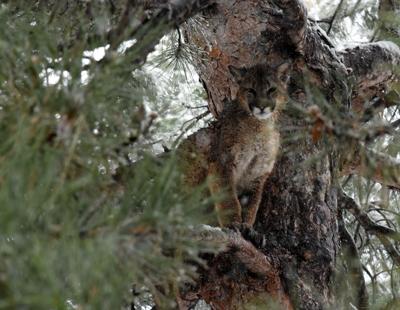Thousands of mountain lions are at home in Colorado, but the elusive predator hasn’t always been seen as an essential member of the state’s ecosystem.
In a series of videos released on YouTube on Monday, Colorado Parks and Wildlife explores how living with mountain lions has changed in the state over the past few years.
The agency’s mammal researcher Matt Aldridge collared 102 independent lions over the 10-year study and found that the common distance the lions would disperse was 60 miles, though some traveled hundreds of miles.
The study showed that mountain lion populations in urban areas were thriving.
Mountain lion interactions with people can range from sightings in backyards, livestock and pet deprivation to direct encounters with humans.
Several mountain lion encounters have made headline news in the past couple of years, such as the mountain lion that was strangled to death after it attacked a jogger outside Fort Collins in 2019 and another encounter that was captured on video outside of Provo, Utah, in October. It showed a lion following a hiker as he walked backwards for six minutes.
Parks and Wildlife spokesperson Randy Hampton said so far this year 83 incidents have involved mountain lions across the state.
The highest number of reports came from the Front Range, with six reports in the Glenwood, Vail, Eagle and Aspen area, and three from western Garfield County and Mesa County.
On Jan. 4, a mountain lion in New Castle was reported walking down a street at 2 p.m.
Earlier this month, numerous reports were made in the north Grand Junction-Fruita area when a mountain lion was reportedly seen near Interstate 70 off 22 and H roads.
The next day, a caller said they heard a mountain lion at night north of Fruita on K Road.
Mountain lions have been seen in the Montrose area as well. Near Ridgway, on Jan. 13, a caller said that a mountain killed an elk and left it near his house. The homeowner reportedly moved the carcass across from their home and the lion was seen in the area over the next few days.
On Feb. 19, a report of a mountain lion around a fence near Montrose came in as well.
Parks and Wildlife estimates 3,800 to 4,400 independent and mature mountain lions are living in Colorado, including dependent young.
New technology like home security cameras allow people to see mountain lions far more often than ever before. In several of the Parks and Wildlife videos, mountain lions can be seen walking around homes looking for prey.
In one video, some rancher’s poor sheep had no chance of escape after a mountain lion jumped a fence to attack. A lion’s annual kill rate is 84 items, according to Parks and Wildlife.
Hampton admitted that ranchers having livestock killed by mountain lions is nothing new in northwest Colorado, but owners do get covered and reimbursed if the livestock is killed by lion or bear.
He said home security cameras have made these investigations much easier.
Of the 868 reports Parks and Wildlife received regarding mountain lions in 2020, one in every nine was seen on a security or trail camera around a home.
“Ten years ago, those items didn’t really exist in broad use, so that 100-plus sightings on security cameras are new and can’t really be compared to a time when we didn’t have (such) cameras everywhere,” said Mark Vieira, the agency’s carnivore and furbearer program manager, in a press release.
“Particularly around houses that aren’t in urban settings and are in mountain lion country, we’ve always had lions, especially at night, using areas around these houses. Homeowners just didn’t know it without cameras everywhere.”
About 17% of the mountain lion reports involved conflicts with livestock, and 11% had deer as the source behind the call to Colorado Parks and Wildlife.
MORE ON MOUNTAIN LIONS
With some male mountain lions weighing over 180 pounds, Colorado’s most elusive predator has had to deal with some unfriendly neighbors over the years.
Until 1965, bounties were paid for their removal as the attitude of early settlers was that they were dangerous and killed livestock as shooting, trapping and use of poison on the animal went unregulated in the early 1900’s, CPW reports. CPW changed the classification of cougars from predator to game mammal and mountain lions became better protected.
Now the cougar is viewed as a valuable member of the Colorado community.
Among the big takeaways of the study was that mountain lions, especially adult females, use urban areas to find prey.
One of the collared lions researched reportedly entered the Boulder-area at night and left during the day, one indicator that they are using these areas for prey while also avoiding human interaction.
In areas with higher house density, such as neighborhoods, 83% of mountain lion use there reportedly occurred between 10 p.m. and 5 a.m.
As such, pets and livestock should be kept close. In the study, 39% of cougars sampled during feeding were found to consume domestic prey like dogs, cats and livestock.












